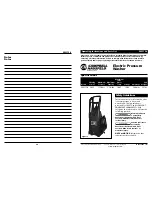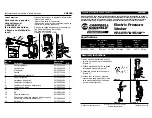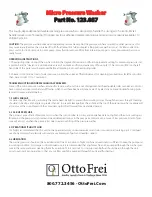
CoMBuSTIon ChaMBER GaS hEaTED InSTRuCTIonS-REGulaTIonS
EN
DiBO 29
6
2. Loosen the lock nut (the upper nut from the two nuts above the pressure spring).
Loosen the lower of the two nuts by turning slowly to the left until drops come out at the angled bush (P. ? Pos. 28).
3. Close the nut again until water is no longer dripping out.
4. Then make another half turn to the right and lock the nut by tightening the upper nut tightly against the lower nut.
Wrongly adjusted safety valves may lead to bursted heating coils and hoses as well as danger to the operators.
9.5 Flow switch
(Page 15, P. 13)
The shift point of the flow switch has to be adjusted to the desired water quantity.
The minimum flow quantity is 6 Litres/ min. The adjustment can be done by shifting the reed contact. Consider the scale!
9.6 Exhaust gas conduit:
.
The following items have to be taken into consideration for the connection to an exhaust gas system:
9.6.1
LBauO / FeuVO (German guidelines for building and fire) have to be considered.
The appropriate authorities should be referred to during the planning.
9.6.2
The clear opening and height of the exhaust systems have to be sized in such a way that the exhaust air will
vent into the open air during all expected operating conditions.
9.6.3
Oppositely the surrounding there must be a chimney draught of 10 Pa or a vaccum of at least 0,2 mbar should exist.
9.6.4
Recommended chimney diameter: at least 200 mm per chimney. Chimney adapters see page 24.
See diagram on page 24, to determine the chimney‘s cross section.
9.6.5
One mutual gas chimney for two combustion chambers. Recommended chimney diameter: at least 350-400 mm.
The exhaust gas conduit has to be effected either via a chimney stalk covering both combustion chambers or by a
closed Y-tube-construction. In any case it is recommendable to consult the responsible chimney man or authorities
before the installation. Chimney adapters make the installation easily, see page 24
9.6.6
Please avoid, due to a vertical air column, a long chimney, as well as 90° bows and bends. (starting problems).
9.6.7
The mouth of the chimney has to be at least 40 cm above the roof ridge or at least 1 m away from the roof surface.
9.6.8
The burner must be fitted with a flame monitor
9.6.9
The chimney connecting pipe, page 24, makes the chimney connection easier. The connecting pipe is available
either in open or in closed type. However, the open type makes the starting procedure easier.
9.7 Installation rooms and additional air control (Consider German regulations LBauO / FeuVO).
9.7.1
Fireplaces with a total heat capacity of more than 50kW may only be installed in rooms, which are not being
used in any other way. The only exception is the simultaneous installation of heating pumps, engine-based co-
generators and internal combustion engines.
The heating rooms must have a volume of at least 8 m3 and a height of at least 2 m.
There has to be at least one exit to the open air or to a floor. For the ventilation of the room an upper and a lower
opening for fresh air has to be installed. The opening must have a cross-section of at least 575 cm2/ combustion
chamber. Alternatively outside air suction can be carried out by means of a pipe system. The according ventilator joint
elements are part of the TEHA- accessories program. The nominal diameter of the suction pipe should be
Ø >=110 mm for each combustion chamber. In case of danger of frost a motor driven lid is recommended.
This lid should be coupled with the burner control in such a way that the burner cannot be started, if the lid is closed.
9.7.2
Special attention has to be paid to the fact that the burner ventilator should not suck in its own or foreign
exhaust gases. The same applies to dust of all kinds, like for example wheel swarf and lacquer dust in production
areas in industry and in workshops.
1. Dust particles build up on the baffle plate, leading to malfunction of the burner within short.
2. The dust particles will secrete on the heating coil and the inner casing and thus cause corrosion.
9.8 Installation of the units in coated machines or areas.
The following items should always be considered:
9.8.1
The unit has to be installed in such a manner that the maintenance of the burner can be carried out at any
time without having to remove parts of the machine or the chimney.
9.8.2
The air damper (page 15, item 31) must be accessible for adjustment.
Summary of Contents for SBH-G-D
Page 2: ......
Page 4: ......
Page 54: ...NL Brander BR1000G instructies en voorschriften DiBO 54 31...
Page 55: ...Brander BR1000G instructies en voorschriften NL DiBO 55 32...
Page 56: ...NL Brander BR1000G instructies en voorschriften DiBO 56 33...
Page 57: ...Brander BR1000G instructies en voorschriften NL DiBO 57 34...
Page 66: ......
Page 68: ......
Page 98: ......
Page 100: ......
Page 150: ...EN Combustion chamber gas heated instructions regulations DiBO 54 31...
Page 151: ...Combustion chamber gas heated instructions regulations EN DiBO 55 32...
Page 152: ...EN Combustion chamber gas heated instructions regulations DiBO 56 33...
Page 153: ...Combustion chamber gas heated instructions regulations EN DiBO 57 34...
Page 162: ......
Page 164: ......
Page 206: ...DE Brennerkammer BR1000G Anweisungen Vorschriften DiBO 46 23 30 Schaltplan BR1000G...
Page 214: ...DE Brennerkammer BR1000G Anweisungen Vorschriften DiBO 54 31...
Page 215: ...Brennerkammer BR1000G Anweisungen Vorschriften DE DiBO 55 32...
Page 216: ...DE Brennerkammer BR1000G Anweisungen Vorschriften DiBO 56 33...
Page 217: ...Brennerkammer BR1000G Anweisungen Vorschriften DE DiBO 57 34...
















































